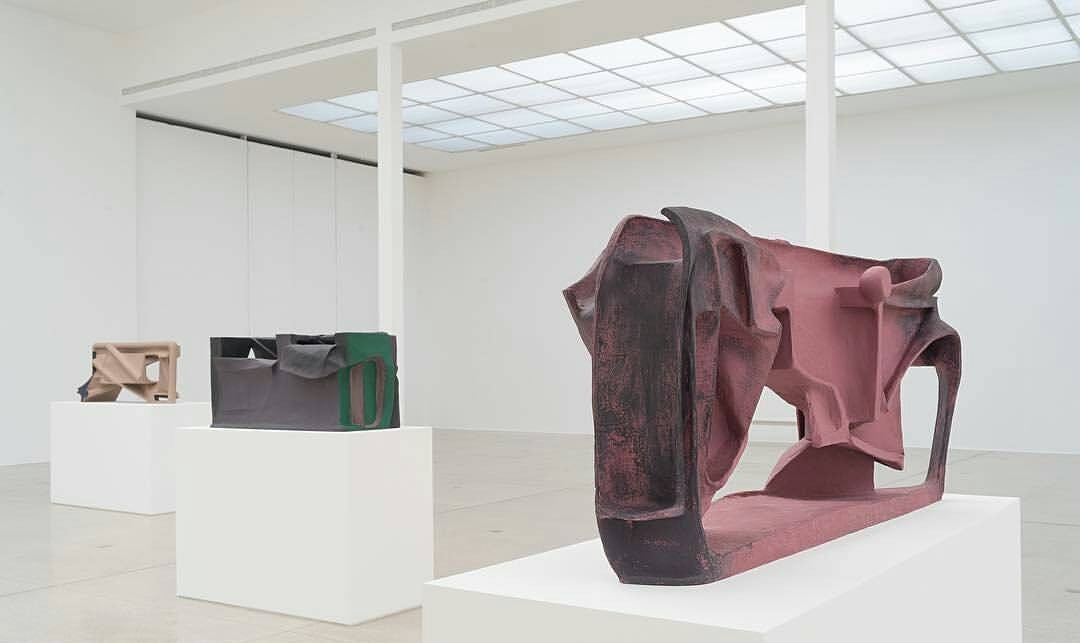Vincent Fecteau
01 Jul - 28 Aug 2016
VINCENT FECTEAU
1 July – 28 August 2016
The American artist Vincent Fecteau’s abstract sculptures defy summary description. Out of everyday staples like papier-mâché, cardboard, pictures from magazines, and paint, he fashions complex objects in which spaces simultaneously collapse and explode. Reminiscent, in many instances, of the elemental forms of early twentieth-century art, his works evoke associations ranging from utopian architecture and avant-garde stage design to masks and industrially manufactured components, yet they do not spell out their references. They keep their secret in a deliberate and insistent refusal to communicate definite meaning, indicating the artist’s emphasis on sculpture as sculpture and the agency it possesses as a real thing in the world.
In his exhibition in the Secession’s main gallery, the first time his work is on display in Austria, Vincent Fecteau presents a new series of ten painted sculptures. Their fairly large rectangular shapes only distantly recall the boxes for cut flower with which the artist started. Alternately adding and removing elements in a playful cumulative practice that is characteristic of his art, Fecteau has transformed them into convoluted volumes.
His chosen material—papier-mâché—is fundamental to the creative process in which his objects come into being. While lacking all productive functionality and largely unrelated to the world around us, papier-mâché is also highly malleable and can be applied and removed in layers. Evincing distinctive traces of how they were made, the sculptures always bear witness to the hand that made them. The immediacy of physical contact as the artist kneaded, modeled, and massaged the material is unmistakable in the finished objects. Their tactile physicality and the surfaces structured by monochrome fields lend them a peculiar bodily presence. The distinctive aesthetic blends baroque ornateness with a hint of futurist eroticism.
The beholders are actively involved in making sense of Vincent Fecteau’s work, which presents very different aspects depending on their vantage point. Seen from the sides, for example, the sculptures appear as fairly slender closed forms, while their front and rear views possess depth, with openings revealing multiple staggered interiors as in a diorama or zograscope. Fecteau perpetually translates one formal logic into another; gifted with a subtle sense of ambivalence, he probes its potential to offer resistance to the blunt assertion of the normal. Ambiguity is thus not just a formal attribute but in fact the true subject of the works and the anchor of their social and political dimension.
The artist’s book Vincent Fecteau has created on occasion of the exhibition was conceived as another such object. It not only attests to his powerful fascination for architecture, interior design, and decoration, but also reflects considerations similar to those that went into the sculptures he was working on at the same time. The special accordion-style binding, for example, introduces a tension between antithetical tendencies of folding up and expansion into space. The collages with their faintly sinister air appear in mirror-inverted duplicate on the hidden interior pages, another instance of unexpected revelation.
1 July – 28 August 2016
The American artist Vincent Fecteau’s abstract sculptures defy summary description. Out of everyday staples like papier-mâché, cardboard, pictures from magazines, and paint, he fashions complex objects in which spaces simultaneously collapse and explode. Reminiscent, in many instances, of the elemental forms of early twentieth-century art, his works evoke associations ranging from utopian architecture and avant-garde stage design to masks and industrially manufactured components, yet they do not spell out their references. They keep their secret in a deliberate and insistent refusal to communicate definite meaning, indicating the artist’s emphasis on sculpture as sculpture and the agency it possesses as a real thing in the world.
In his exhibition in the Secession’s main gallery, the first time his work is on display in Austria, Vincent Fecteau presents a new series of ten painted sculptures. Their fairly large rectangular shapes only distantly recall the boxes for cut flower with which the artist started. Alternately adding and removing elements in a playful cumulative practice that is characteristic of his art, Fecteau has transformed them into convoluted volumes.
His chosen material—papier-mâché—is fundamental to the creative process in which his objects come into being. While lacking all productive functionality and largely unrelated to the world around us, papier-mâché is also highly malleable and can be applied and removed in layers. Evincing distinctive traces of how they were made, the sculptures always bear witness to the hand that made them. The immediacy of physical contact as the artist kneaded, modeled, and massaged the material is unmistakable in the finished objects. Their tactile physicality and the surfaces structured by monochrome fields lend them a peculiar bodily presence. The distinctive aesthetic blends baroque ornateness with a hint of futurist eroticism.
The beholders are actively involved in making sense of Vincent Fecteau’s work, which presents very different aspects depending on their vantage point. Seen from the sides, for example, the sculptures appear as fairly slender closed forms, while their front and rear views possess depth, with openings revealing multiple staggered interiors as in a diorama or zograscope. Fecteau perpetually translates one formal logic into another; gifted with a subtle sense of ambivalence, he probes its potential to offer resistance to the blunt assertion of the normal. Ambiguity is thus not just a formal attribute but in fact the true subject of the works and the anchor of their social and political dimension.
The artist’s book Vincent Fecteau has created on occasion of the exhibition was conceived as another such object. It not only attests to his powerful fascination for architecture, interior design, and decoration, but also reflects considerations similar to those that went into the sculptures he was working on at the same time. The special accordion-style binding, for example, introduces a tension between antithetical tendencies of folding up and expansion into space. The collages with their faintly sinister air appear in mirror-inverted duplicate on the hidden interior pages, another instance of unexpected revelation.


